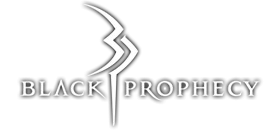Fourth Art Dev Diary Focuses on Tyi Faction Design
Black Prophecy Art Director Nick Ebenhoch has written the fourth part of his Art Direction Developer Diary, and this one focuses on the design of the Tyi faction. In case you missed it, the third part provided background information and details about the human faction.
"The mentality of the Tyi is characterized by their aspiration for strength and technological progress," Ebenhoch said. The faction doesn't care about cleanliness as long as everything works. "Like the Humans, the Tyi utilize modular construction which enables them to produce sheer unlimited variations of space ships and stations and to adjust them quickly and easily as required," he said.
You can read the full dev diary entry after the jump. For more information on the game, check out our recent interview with Creative Director Timo Krahl.
The mentality of the Tyi is characterized by their aspiration for strength and technological progress. It was our explicit goal to communicate these traits through the faction logo. For the groundwork of the logo we have chosen massive metal as this shows an impression of strength and robust technology. The two metal rings illustrate cogs in an abstract form and symbolize the workings of a complex system. The bronze, nearly rust-colored rear ring should outline that the Tyi don’t place value on absolute cleanliness as long as everything works according to their vision. The center of the logo shows the Tyi home world “Murna”, to which they are closely linked. The coloring of the planet also shows the primary color of the Tyi. Further typical colors are yellow, orange and red which are supposed to outline an aggressive character.
Space ships and stations
Similar to the Human design the forms were meant to be kept simple but appear far more technical and less tidied up. Greeble-like surfaces (Greeble is a technique in the graphics creation with which an object or surface can be designed optically more complex and interesting) proved to be an optimal solution for this. The wall areas are kept rough and erratic as the use of too many details would have exceeded the technical possibilities.
The distinctive characteristic for the Tyi capital ships and stations is the way they are built into width and length. While capital ships have a fixed height and variable length, the modular system allows building stations upward and therefore the creation of enormous, complex cities. The previously mentioned inspiration by the 80’s sci-fi look shows up in a very distinctive form with less glossy surfaces, bright gray hues and pale yellow engine colors in the design of the Tyi ships and stations.
Like the Humans, the Tyi utilize modular construction which enables them to produce sheer unlimited variations of space ships and stations and to adjust them quickly and easily as required. This modular system has significantly influenced the construction of the Tyi space fighter.
As the Tyi prefer a rather flat and longish ship design, the space fighters look quite different from the classical design conceptions. A fighter consists, apart from the cockpit, of two wings that are connected to two engine modules which can be exchanged flexibly. Thus, the fighter can be equipped with more powerful and larger modules as required. The weapon carriers are located within the wings as this position provides more protection against enemy fire. The following screenshots show the Tyi space fighter in a high configuration level which has a much more aggressive look compared to the smaller version.
The cockpit module has a small auxiliary engine that is deployed to ensure the safe return of the pilot if the main engines are destroyed. The cockpit is technically far more advanced than the human ships. The control panels with the orange touch-screen display allow access to most of the ship functions and make further knobs and switches nearly redundant. Thick cable conductors along the cockpit strutting enhance the technical look. Depending on the configuration level of the cockpit, the control panels are bigger, the window strutting thicker and the displays more complex whereby we always paid attention to create an authentic design in which the pilot get his bearing.
In contrast to the space fighters there are fewer possible combinations for capital ships due to constructional conditions. The base is built out of the stern and front modules that can be extended with additional different modules at the center. The single modules again consist of smaller modules that are assembled to so-called macro modules within the 3D application. With these macro modules the game or level designer can assemble ships as required for the each different scenario. It is possible to assemble ships several kilometers long without problems. The large surfaces of the capital ships are covered with simple plate structures, while the side parts are decorated with lots of technical details. This should outline the impression of a very tough battle ship.
For the space stations we made use of a similar approach except that the stations consist of less coherent modules in comparison to the capital ships. Like the Human stations, the Tyi assemble their stations out of single modules that are linked with connectors which creates the optical impression of a road network. Usually the stations of the Tyi are built wide rather than high, although it is possible to use a multi-layered system which spreads over several levels. From a distance, the surface details of the stations appear very noisy because of the size of the single modules, but become calmer if you get closer. The practical use is more important to the Tyi than having a great look. Overall the stations have fewer windows as these are considered a weak point for possible enemy attacks and also support the minimalistic approach for the whole station design.
This is it for part four of the Art Direction Developer Diaries. In the fifth and last part I will present you the third main faction, the Genides.
Stay tuned!




